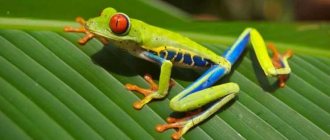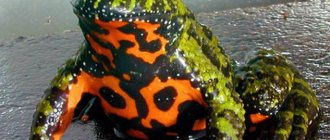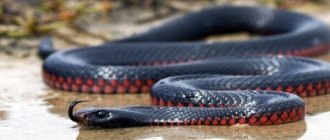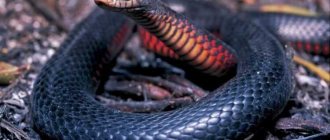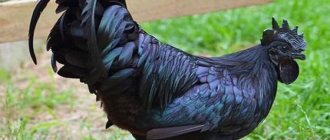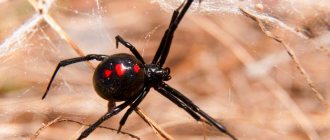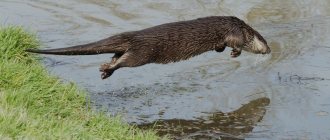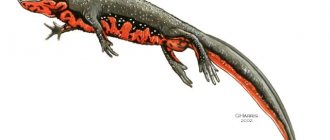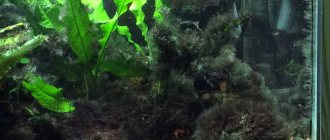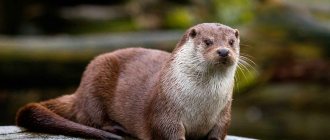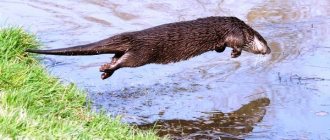The red-bellied black snake (Pseudechis porphyriacus) or black echidna belongs to the genus Black Snakes of the Slate family. This species is on the list of the most poisonous snakes in the tropics and is quite dangerous. Australians simply call it “black snake.” The species was first described by George Shaw in 1794 in a book on the zoology of New Holland.
Red-bellied black snake (Pseudechis porphyriacus)
The red-bellied black snake (Pseudechis porphyriacus) is native to eastern Australia. Although its venom can cause significant poisoning, the bite does not lead to death. This species of snake is less venomous than other deadly Australian snakes.
External signs of a red-bellied black snake
The red-bellied black snake has a body length of 1.5 meters to two and a half meters. The reptile's skin on the dorsal side is glossy black with a bluish tint. The lower body and sides are colored pinkish, red, crimson-red, and have a noticeable black border. The front end is light brown. The scales on the skin are smooth and symmetrically located. The head of the red-bellied black snake is elongated. Brown spots appear near the nostrils or around the eye sockets.
The red-bellied black snake has a body length of 1.5 meters to two and a half meters.
Poisonous teeth are located in front of the upper jaw. They look like fangs, curved inwards and are much larger compared to other teeth. Each poisonous tooth has a channel for draining the poison. Usually the reptile uses only one tooth, the second fang serves as a backup in case the snake loses one of them. The remaining teeth are much smaller, without a poisonous canal.
Warnings
- Be careful when working, walking, resting, etc. in areas where snakes are found.
- Coral adders are very poisonous, stay away from them.
- Striated kingsnakes are not venomous, but they can still bite you painfully.
- This rule does not work for all types of coral adders. For example, the color of one of the species of coral adder "Cobra adder": red, black, yellow, black, yellow, black, red. This species has red stripes touching black ones, but is highly poisonous. Usually within five minutes after the bite a person is paralyzed, and within an hour death occurs.
Features of behavior of the red-bellied black snake
The red-bellied black snake is not an aggressive species and does not tend to attack first. When life is threatened, he tries to escape from his pursuer. Characterized by activity during the daytime. When the pond warms up, it can hide under water for almost an hour, swims and dives superbly. After the hunt, it hides under snags, stones and heaps of garbage. Crawls into holes, holes and crevices.
In case of danger, the red-bellied black snake slightly spreads its ribs to the sides.
At the same time, the body shape flattens and becomes wider, while the reptile resembles a cobra with an inflated hood. In case of a serious threat, the snake raises its neck to a height of 10 - 20 above the surface of the earth and throws the front part of its body towards the enemy, inflicting a bite with poisonous teeth.
The red-bellied black snake is not an aggressive species
In nature, real fights often occur between males of this species of snake. Two males with their heads raised attack each other, trying to tilt the opponent's head down. Then the winner abruptly wraps his flexible body around the opponent and crushes his competitor with a hiss. Then the strongest male loosens his grip, and the snakes disperse to prolong the competition again.
One encounter lasts about one minute, and the entire tournament lasts until the males are completely weakened. Sometimes the fight becomes fierce, and the reptiles are so tightly intertwined that the black “ball” can be lifted from the ground. Such intraspecific struggle is for the right to possess a certain territory and occurs during the mating season. But even the most brutal fights can be done without the use of poisonous teeth.
Boa constrictors
Anaconda
The most famous type of boa constrictor. The anaconda is famous for its huge size, up to 6.5 meters in length. No modern snake can boast of such dimensions. It is found in the South American tropics.
Interesting fact! In 1944, the longest anaconda in the world was found. The length of her body was more than 11 meters. The scales of this huge boa constrictor are dark green in color. There may be dark circles on his body and yellow circles on the sides. Despite the lack of poison, this animal can cause harm to humans, primarily through painful bites. But you won’t have to expect any damage from him if you don’t bother him.
Anaconda loves water, so it can be found near rivers and lakes. She can lie in the sun for a long time, warming herself, but still spends most of the day in the water. By the way, that's where she sheds. Most often, the anaconda's prey is aquatic birds, but it also hunts mammals, lizards and fish.
Common boa constrictor
The boa constrictor is a type of snake that rarely crawls into dry areas. It is found near bodies of water. This species is common in Central America. Birds and small animals become its prey.
Due to the lack of poison and interesting appearance, some people prefer to keep these large scaly ones at home. However, you need to be prepared for the fact that in captivity they will have to be fed with live rodents or chickens. Unusual patterns are visible on the body of the individual. She reaches sexual maturity by 3 years.
Dog-headed boa
This beautiful light green boa constrictor is found in the South American tropics. It is considered one of the largest snakes, up to 3 meters long. On the back of this animal you can clearly see white scales forming thin, uneven stripes.
The dog-headed boa is very fond of trees. Thanks to its tenacious tail, it is able to firmly anchor itself on a thick branch, even hanging upside down. This is one of the few types of snakes that are easy to tame. In captivity, he behaves calmly and cautiously, resting most of the day. The diet of the dog-headed boa consists of birds.
Sand boa
The species is widespread in Africa, Western Europe and Asia. The sand boa is a spotted snake. Its sand-colored body may have light or dark brown scales that form circles. This animal is attracted to dry steppes.
It feeds on mice, turtles, lizards and some birds. The female of this scaly species is 1.5 times larger than the male. The sand boa has very small teeth, which makes its bite quite unpleasant. However, they do not contain poison, therefore, the bite does not pose a mortal danger to humans.
Rainbow boa
This is one of the few species of reptiles on whose body you can see rainbow highlights. The color of this individual is quite interesting. The main color of its scales is brown, but light and dark scales form circular shapes, each of which has a dark rim.
The snake's body shines only when exposed to ultraviolet rays. It is interesting to watch her movement in sunny weather. By the way, the rainbow boa constrictor is an excellent swimmer.
Madagascar boa constrictor
Endemic to the island of Madagascar. Can grow up to 3 meters. The main color of the scales of this reptile is brown. There are diamond-shaped figures on his body. When the animal crawls out into an area well lit by the sun, its body turns metallic greenish.
Zoologists distinguish a subspecies of such a snake – the Madagascar arboreal boa constrictor. He spends most of the day under dense bushes or in a wooden crown. The animal has to leave its hiding place in order to hunt. Usually, it tracks prey near a body of water.
Ribbed Candoya
This snake is excellent at climbing trees. Lives on the island of New Guinea. It should be noted that this type of squamate has been poorly studied. The color of the individual is light. There are zigzag patterns on her body. The ribbed candoya hunts in the evening or at night. Its prey is small rodents, such as mice.
garden boa
It lives in Venezuelan and Colombian forest areas with high humidity levels. The maximum length of such an individual is 1.7 meters. The color of the scales of a garden boa can be black, sandy, red, gray and others. Fuzzy figures can be seen on its dorsal part.
The individual hunts mainly at night. She spends the day in a wooden hollow. Often, nests abandoned by birds become places for this animal to spend the night.
Smooth-lipped boa
Jamaican endemic. The female smooth-lipped boa can grow up to 2.5 meters. Males are slightly smaller, up to 2 meters. The body of the individual is covered with red and black scales. Sometimes fuzzy yellow spots are visible on it. At night, this animal is more active than at night. It leads a terrestrial lifestyle. The main food of the smooth-lipped boa is bats.
Tree Mascarene boa
A very rare species, endemic to Round Island. The maximum length is one and a half meters. The peculiarity of the species is its sharp tail tip. The color of the animal’s scales is dark olive or brown. But there may be small white stripes on his body. The lifestyle is nocturnal.
The red-bellied black snake is a venomous reptile
The red-bellied black snake has a poisonous toxin that it uses to immobilize its prey and protect itself. The reptile is able to lie on the bottom of the river and rest. In this case, it poses a danger to bathing people, who may inadvertently step on the snake. Although she attacks only if they try to catch her or disturb her.
In nature, real fights often occur between males of this species of snake.
The death of the body from the bite of a red-bellied black snake does not always occur, but signs of poisoning by the toxin appear. The poison, which is released in large quantities during hunting and has a strong effect on the prey, is produced in smaller quantities during defense. The poisonous substance secreted by the red-bellied black snake includes neurotoxins, myotoxins, coagulants and has a hemolytic effect. A reptile bite is not too dangerous, but victims also need urgent medical attention. A smaller dose is used as an antidote, since it is cheaper, but the medicine in a smaller quantity also causes a reaction in the patient and gives a positive result.
Links[edit]
Quotes [edit]
- ^ a b
"
Pseudechis porphyriacus
".
IUCN Red List of Threatened Species
.
2017
: e.T42493274A42493282. 2022. doi: 10.2305/IUCN.UK.2018-1.RLTS.T42493274A42493282.en.| date = / | doi = mismatch - ^ a b c
Australian Biological Resources Survey (26 August 2013).
"Species Pseudechis porphyriacus
(Shaw, 1794)".
Handbook of Australian Fauna
. Canberra, Australian Capital Territory: Australian Government Department of Environment, Water, Heritage and the Arts. Retrieved December 6, 2022. - Pseudechis porphyriacus
species in the Reptile Database. www.reptile-database.org. - ^ a b c
Shaw, George (1794).
Zoology of New Holland
. London, UK: J. Sowerby. pp. 27–28. - ^ a b
Williams, David;
Wüster, Wolfgang; Fry, Brian Grieg (2006). "The good, the bad and the ugly: Australian snake taxonomists and the history of Australian venomous snake taxonomy". Toxicon
.
48
(7): 919–30. DOI: 10.1016/j.toxicon.2006.07.016. PMID 16999982. - Jump up
↑ Liddell & Scott 1980, p. 579. - Lacépède, B. G. E. (1804). "Mémoire sur plusieurs animaux de la Nouvelle-Hollande dont la description n'a pas encore été publiée". Annales du Muséum National d'Histoire Naturelle. Paris
.
4
: 184–211 [209], [pl. 56 pics 1]. - Lesson, R.P. (1826). "Reptiles". . In Duperrey, L. I. (ed.). Voyage Autour du Monde, Exécuté par Ordre du Roi, sur la Corvette de sa Majesté, La Coquille, Pendant les Années 1822, 1824 and 1825. Zoologie, Atlas
. Paris: Arthus Bertrand. - Schlegel, Hermann (1837). Essai sur la Physionomie des Serpens. Partie Générale et Partie Descriptive
(in French).
2
. La Haye: Kips and Stockum. pp. 479–80. - Table X from: Zoology and Botany of New Netherland and Adjacent Islands
/ Zoological Part by George Shaw, Botanical Part by James Edward Smith; figures by James Sowerby. - Wagler, Johann Georg (1830). Natürliches System der Amphibien, mit vorangehender Classification der Säugethiere und Vogel
(in German). Munich, Germany: Cotta'schen. paragraph 171. - McKay, Roy D. (1953–54). "A revision of the genus Pseudechis
.
Proceedings of the Royal Zoological Society of New South Wales
.
74th
: 15–23. - Jump up
↑ Liddell & Scott 1980, p. 795. - Jump up
↑ Liddell & Scott 1980, p. 295. - Worrell, Eric (1961). "Herpetological name changes" (PDF). Western Australian Naturalist
.
8
: 18–27. Archived from the original (PDF) on March 19, 2012. Retrieved January 17, 2012. - Maddock, Simon T.; Childerston, Aaron; Fry, Brian Grieg; Williams, David J.; Barlow, Axel; Wüster, Wolfgang (2017). "Multilocal phylogeny and species delimitation of Australo-Papuan black snakes ( Pseudechis
Wagler, 1830: Elapidae: Serpentes)" (PDF).
Molecular phylogenetics and evolution
.
107
: 48–55. DOI: 10.1016/j.ympev.2016.09.005. hdl: 2436/621498. PMID 27637992. - ^ a b
Hoser, Raymond (2003).
A reassessment of
the taxonomy of Red-bellied black snakes (genus
Pseudechis
) with descriptions of two new subspecies" (PDF).
Boydii - Journal of the Herpetological Society of Queensland
(Autumn (May)): 15–18. - Kaiser, Hinrich; Crother, Brian I.; Kelly, C.M.R.; Luiselli, Luca; O'Shea, Mark; Ota, Hidetoshi; Passos, Paulo; Schleip, Wulf D.; Wüster, Wolfgang (2013). "Best Practices: In the 21st Century, taxonomic decisions in herpetology are only acceptable if they are supported by a body of evidence and published through peer review" (PDF). Herpetological Review
.
44
(1): 8–23. - ^ a b c d e f g h i j k l m n o p
Beatson, Cecily (5 May 2022).
"Red-bellied Black Snake". Australian Museum website
. Australian Museum. Retrieved May 19, 2022. - Troy, Jakelin (1993). Sydney Language
(PDF). Canberra: self-published. paragraph 53. ISBN 0-646-11015-2. - ^ a b
Sutherland & Tibballs 2001, p. 139. - ^ a b c
Australian Reptile Park. "Red-bellied Black Snake". Somersby, New South Wales. Archived from the original on January 3, 2008. Retrieved December 28, 2007. - Australian Broadcasting Corporation (3 October 2014). "Huge Red-bellied Black Snake Surprises Newcastle Wrangler Called to Remove It". ABC News
. Retrieved December 4, 2022. - Jump up
↑ Greer 1997, p. 163. - Bennett, George (1860). A Naturalist's Collection in Australasia: Observations Chiefly on the Animals and Plants of New South Wales, New Zealand, and Some of the Islands of Australia
. London: J. Van Vorst. pp. 274–76. - Krefft, Gerard (1869). Snakes of Australia: An Illustrated and Descriptive Catalog of All Known Species
. Sydney, NSW: T. Richards, Government Printing Office. pp. 46–47. - Hutchinson, Mark; Williams, Ian (2018). "The Key to the Snakes of South Australia" (PDF). South Australian Museum
. Government of South Australia. Retrieved February 8, 2022. - Macdonald, Stuart. "searching for the snake scale counter". Online Database of Australian Reptiles
. Retrieved May 3, 2022. - ^ a b
Sutherland & Tibballs 2001, p. 140. - ^ B s d e e
Shoe, Richard (1987).
"Intraspecific differences in thermoregulation, locomotion and habitat use of Australian black snakes, Pseudechis porphyriacus
(Elapidae)" (PDF).
Journal of Herpetology
.
21
(3): 165–77. DOI: 10.2307/1564479. JSTOR 1564479. - Mirtschin, Rasmussen & Weinstein 2022, p. 116.
- ^ a b
Gilbert, P. A. (1935).
"Black Snake". Proceedings of the Royal Zoological Society of New South Wales
.
55
: 35–37. - ^ a b
Greer 1997, p. 139. - ^ a b c
Mirtschin, Rasmussen & Weinstein 2022, p. 117. - Jump up
↑ Greer 1997, p. 140. - Mirtschin, Rasmussen & Weinstein 2022, p. 43.
- Ormsby, A. I. (1952). "Notes on Snake Hibernation in New South Wales". Proceedings of the Royal Zoological Society of New South Wales
.
71
: 25–27. - Hoser, Raymond T. (1980). "Further records of assemblages of various species of Australian snakes". Herpetofauna
.
12
(1): 16–22. - Shine On, Richard; Grigg, Gordon C.; Shine, Terry J.; Harlow, Peter (1981). "Mating and male combat in Australian black snakes, Pseudechis porphyriacus
(PDF).
Journal of Herpetology
.
15
(1): 101–07. DOI: 10.2307/1563652. JSTOR 1563652. - ^ a b c d
Sutherland & Tibballs 2001, p. 141. - Cogger, Harold G. (1983) [1979]. Reptiles and Amphibians of Australia
(Rev. ed.). Reid. item 449. ISBN. 978-0-88359-048-5. - Shine, Richard (1978). "Growth rates and sexual maturation of six species of Australian cartilaginous snakes". Herpetologica
.
34
(1):73–79. JSTOR 3891614. - ^ a b
Eipper, Scott (2012).
Guide - Australian Snakes in Captivity: Elapids & Colubrids
. Reptile Publications. item 237. ISBN. 978-0-9872447-8-9. - Jump up
↑ Greer 1997, p. 145. - ^ a b
Greer 1997, p. 147. - Phillips, Ben L.; Shine On, Richard (2006). "An invasive species causes rapid adaptive changes in a native predator: cane toads and black snakes in Australia". Proceedings of the Royal Society B: Biological Sciences
.
273
(1593): 1545–50. DOI: 10.1098/rspb.2006.3479. PMC 1560325. PMID 16777750. - Broad, A.J.; Sutherland, UK; Coulter, A. R. (1979). "The lethality of dangerous Australian mice and other snake venoms." Toxicon
.
17
(6): 661–64. DOI: 10.1016/0041-0101 (79) 90245-9. PMID 524395. - Johnston, Christopher I.; Ryan, Nicole M; Page, Colin B; Buckley, Nicholas A; Brown, Simon G.A.; O'Leary, Margaret A; Isbister, Geoffrey K. (2017). "Australian Snakebite Project, 2005–2015." (ASP-20)" (PDF). Medical Journal of Australia
.
207
(3):119–25. DOI: 10.5694/mja17.00094. LVP: 1959.13 / 1354903. PMID 28764620. S2CID 19567016. - ^ a b c
Mirtschin, Rasmussen & Weinstein 2022, p. 119. - Mirtschin, Rasmussen & Weinstein 2022, p. 101.
- ^ a b
Mirtschin, Rasmussen & Weinstein 2022, p. 110. - Weinstein, Scott; Mircin, Peter J.; Tristram, Hamish; Lawton, Luke; White, Julian (2018). "Local morbidity from envenomation
by the red-bellied black snake (
Pseudechis porphyriacus
, Elapidae): two cases and a summary of treatment."
Toxicon
.
142
: 34–41. DOI: 10.1016/j.toxicon.2017.12.047. PMID 29269114. - ^ a b
Churchman, Andrew;
O'Leary, Margaret A; Buckley, Nicholas A; Page, Colin B; Tankel, Alan; Gavaghan, Chris; Holdgate, Anna; Brown, Simon G.A.; Isbister, Geoffrey K. (2010). "Clinical effects of
red-bellied black snake (
Pseudechis porphyriacus
) envenomation and correlation with venom concentration: Australian
Snakebite
(ASP-11)".
Medical Journal of Australia
.
193
(11):696–700. DOI: 10.5694/j.1326-5377.2010.tb04108.x. PMID 21143062. S2CID 15915175. - Vaughan, Gary T.; Scully, Thomas B.; Tyrrell, Roy (1981). "Isolation of a hemolytic toxic phospholipase from the venom of the Australian red-bellied black snake ( Pseudechis porphyriacus
)".
Toxicon
.
19
(1):95–101. DOI: 10.1016/0041-0101 (81) 90121-5. PMID 7222091. - Schmidt, J. J.; Middlebrook, J. L. (1989). "Purification, sequencing and characterization of pseudodexine phospholipases A2 from Pseudechis porphyriacus
(Australian red-bellied black snake)".
Toxicon
.
27
(7): 805–18. DOI: 10.1016/0041-0101 (89) 90048-2. PMID 2675391. - Sutherland & Tibballs 2001, p. 142.
- Heller, J.; Bosward, K. L.; Hodgson, JL; Cole, Florida; Reid, South Africa; Hodgson, D. R.; Mellor, D. J. (2005). "Snake poisoning in dogs in New South Wales". Australian Veterinary Journal
.
83
(5):286–92. DOI: 10.1111/j.1751-0813.2005.tb12743.x. PMID 15957391. - Heller, J.; Bosward, K. L.; Hodgson, D. R.; Potti, R. (2006). "Anuric renal failure in a dog following envenomation
by the Red-bellied black snake (
Pseudechis porphyriacus
.
Australian Veterinary Journal
.
84
(5): 158–62. DOI: 10.1111/j.1751-0813.2006.tb12769.x. PMID 16739524.
Books cited[edit]
- Greer, Allen E. (1997). Biology and evolution of Australian snakes
. Chipping Norton, NSW: Surrey Beatty and Sons. ISBN 978-0-949324-68-9. - Liddell, Henry George; Scott, Robert (1980) [1871]. Greek-English Lexicon
(Abridged Edition). Oxford, United Kingdom: Oxford University Press. - Mirchin, Peter; Rasmussen, Arne; Weinstein, Scott (2017). Australia's dangerous snakes: identification, biology and envenomation
. Clayton South, Victoria: Csiro Publishing. ISBN 978-0-643-10674-1. - Sutherland, Struan K.; Tibballs, James (2001) [1983]. Australian Animal Toxins
(2nd ed.). South Melbourne, Victoria: Oxford University Press. ISBN 978-0-19-550643-3.
Reproduction of the Red-bellied Black Snake
The red-bellied black snake is an ovoviviparous reptile. From 8 to 40 cubs develop in the female’s body. Each baby is born surrounded by a membranous sac. The length of the baby snake reaches 12.2 cm. The offspring die from predators and unfavorable environmental conditions, so only a few individuals from the brood give birth to offspring.
The red-bellied black snake is an ovoviviparous reptile.
Differences in head and eyes
If there is contact between a snake and a person, then the head of the snake can be clearly seen. Try to see the snake's eyes.
- The snake has a round pupil, and the iris is often visible.
- The viper's pupil is vertical (like a cat's).
On the left is a viper, on the right is a snake.
- The snake has an oval head, light spots are visible at the end of the head. In common parlance – “ears”.
- The head of the viper is triangular, sharp in shape.
On the left is a viper, on the right is a snake.
Keeping the red-bellied black snake in captivity
When breeding the red-bellied black snake, reptile lovers treat it with great caution, knowing about its poisonous characteristics. A closed terrarium is selected for maintenance; the temperature is maintained in it - 22 and up to 28 degrees. For shelter, wooden houses and stone grottoes are installed, preferably in a shady area. Large wood shavings are used as bedding. The air in the terrarium is not allowed to dry out and wet spraying is done three times a week.
The red-bellied black snake is fed small rats, mice, and frogs. It is advisable to take proven food, since the reptile’s body reacts to toxic substances that may be in the body of a frog living in a polluted pond.
If you find an error, please select a piece of text and press Ctrl+Enter.
What does it look like? How to distinguish a snake from a viper
Few people are not afraid of snakes. Fear of reptiles is in human blood. And this is no coincidence, because the bite of a viper, which is common in our country, is very dangerous and can be fatal. But quite often it is confused with a non-venomous snake, which is a little similar to it. This snake is not aggressive, and its bite, although painful, is not dangerous. You can encounter both snakes and vipers while relaxing in nature, walking through the forest, and even at your summer cottage. Usually, when a person sees a reptile, he gets scared and sometimes tries to kill it. You need to know what a snake looks like in order to know how to behave when meeting a snake. It’s better not to touch it at all, and if you recognize the viper, then try to get away from it.
Protection
First of all, you should remember that snakes almost never attack themselves. When danger arises, it curls up into a tight ball and hisses, but more often it pretends to be dead; it is not aggressive. It can also emit a protective pungent odor reminiscent of garlic.
Vipers can be quite aggressive - if they defend themselves. They can defend themselves for a long time, and sometimes attack inanimate objects if they feel threatened. If you catch a snake by surprise and get too close, it may hiss and lash out. However, the throw of a viper does not exceed a quarter of its length, i.e. 15-25 cm.
Protection
First of all, you should remember that snakes almost never attack themselves. When danger arises, it curls up into a tight ball and hisses, but more often it pretends to be dead; it is not aggressive. It can also emit a protective pungent odor reminiscent of garlic.
Vipers can be quite aggressive - if they defend themselves. They can defend themselves for a long time, and sometimes attack inanimate objects if they feel threatened. If you catch a snake by surprise and get too close, it may hiss and lash out. However, the throw of a viper does not exceed a quarter of its length, 15−25 cm.
